St Kitts Tourist Attractions
Explore a carefully preserved world heritage site at the Brimstone Hill Fortress, charming historical architecture and old churches in the bustling capital of Basseterre and lavish colonial estates featuring fascinating examples of Carib petroglyphs. St. Kitts offers fascinating sights that will engage all your senses in every direction.
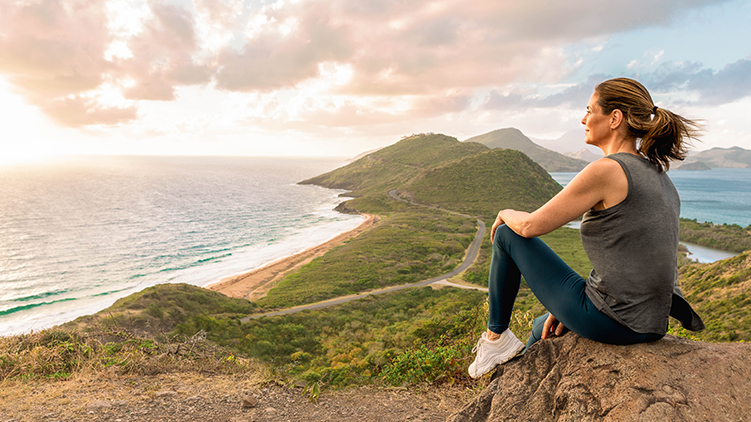
-
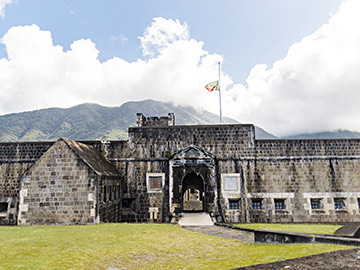
Brimstone Hill Fortress
Brimstone Hill Fortress National Park is a UNESCO World Heritage Site of historical, cultural and architectural significance. This centuries-old citadel is a monument to the ingenuity of the British military engineers who designed it and to the skill and strength of the African slaves who built it on the steep at the risk and probable loss of lives. The walls are predominantly made of stone, painstakingly carved from Brimstone Hill’s hard volcanic rock. The mortar was produced from the limestone that covers much of the middle and lower slopes. Begun in the 1690s, the fortress finally took shape as a complete military community in the 1790s. This prominent citadel is one of the earliest and finest surviving examples of a new style of fortification known as the polygonal system. Its elevated vantage point offers panoramic vistas of forested mountains, cultivated fields, the historical township of Sandy Point, and neighboring Dutch, English and French islands across the Caribbean Sea.
Learn More -
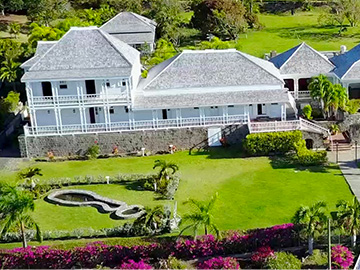
Fairview Great House & Botanical Gardens
This 18th century Great House has been authentically restored to its former glory with careful attention to historical detail. Step back in time as you wander through the dining room with its sixteen seat mahogany dinner table and antique silver service, as well as the Historical Room that chronicles the fascinating past of Fairview. Step on to the master bedroom veranda and enjoy the breathtaking panoramic vista of the Caribbean Sea, South-East Peninsula and St. Kitts’ sister island of Nevis. Then take a leisurely stroll through the Botanical Garden filled with local flora, identified with signage providing interesting information about each. Don’t forget to keep an eye out for the monkeys who love to feast on the fruit trees on the property.
Learn More -
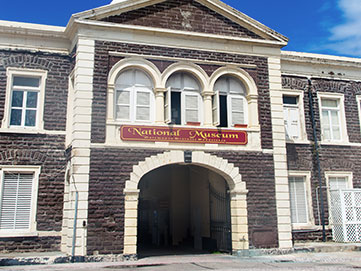
Old Treasury Building & Museum
The Treasury Building, known affectionately as the “Old Treasury Building” is one of the most outstanding architectural buildings in downtown Basseterre. Built in 1894, this impressive structure has been witness to the procession of life in the nation’s capital for over a hundred years. The foundation stone was laid by Lady Haynes-Smith, the wife of then Governor Sir William Haynes. In addition to the treasury, it also housed the offices of the administrator, customs, audit, supply and post office. The treasury building adopted the name “The Gateway to the Island”, as its imposing archway led the way to the streets of Basseterre for many visitors and travelling residents arriving by boat. The two-story stone structure designed in Georgian architectural style is one of the more interesting buildings to be seen around Basseterre. For years the dome at the top of the building served as a lighthouse guiding hundreds of captains that docked boats and ships at the treasury landing pier.
Learn MoreHours Of OperationPricingMonday - Friday
9:15am - 5:30pm
Saturday
9:15am - 1:00pm
Sunday
9:00am - 1:00pm
General Admission
FREE
-
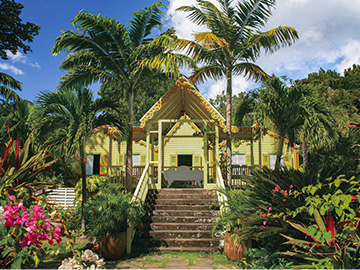
Romney Manor
Owned and run by successive Earls of Romney over the centuries, no visit to St. Kitts is complete without a tour of the Historic Romney Manor and its pristine gardens featuring an over 300-year-old SAMAN tree. If trees could talk, this one could tell the entire story of the Caribbean. This majestic setting is now home to the island’s Caribelle Batik craft. Visitors witness the fascinating process of Caribelle Batik demonstrated here and everything from casual wear, accessories and gift items made of Caribelle Batik are available for sale on the premises.
Learn MoreHours Of OperationPricingMonday - Friday
8:30am - 4:00pm
During Peak Season (October-April)
Monday - Friday
8:30am- 4:00pm
Saturday - Sunday*
8:30am - 4:00pm
On cruise ship days onlyAdults
$3.00 USD
Children
(0-11)FREE
Residents
$2.00 USD
Accredited Resident Students
FREE
Wheelchair accessible
-
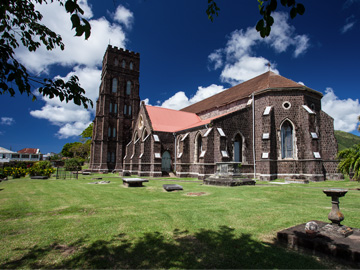
St. George's Anglican Church
First erected in 1670 as a Roman Catholic Church by French Jesuits and named Notre Dame, over the centuries this ancient church has faced bloody battles, fire and even natural weather disasters, each time restored or completely rebuilt. In 1706 Notre Dame was burnt to the ground during the Anglo-French War by English soldiers billeted there. The church was re-built by 1710 and re-named St. George’s. From the 1720’s, it became a place of worship for the Anglicans. It was damaged again in the fire of 1763, and once again restored. The earthquake of 1842, followed by the hurricane of 1843, reduced it to ruins, and an entirely new building was planned. But the congregation continued to worship in the ruins until a new church was consecrated on the 25th March, 1859. Seven years afterwards, it was gutted in the Great Fire of 1867; and was re-roofed, and restored in 1869. In a series of hurricanes since 1989, the church was again damaged but restoration work has since been undertaken on the building.
Learn MoreHours Of OperationPricingMonday - Friday
9:00am - 5:00pm
Sunday
8:00am - 5:00pm
General Admission
FREE
-
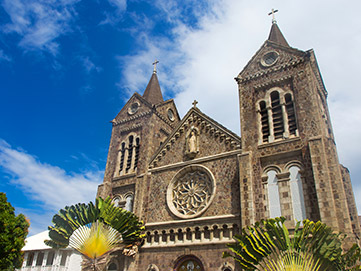
Church of Immaculate Conception
An ornate church constructed out of grey stone and located on the eastern side of Independence Square in Basseterre. After the English take over in 1713, Roman Catholics were forbidden by law to worship in public. They were prohibited from civil or military office unless they took and subscribed to certain oaths and declarations. In 1829, an act was passed removing all such restrictions. Catholicism began to flourish on the island of St. Kitts during the nineteenth century thanks to Irish and Portuguese immigrants. A church was built in 1856 called the Church of the Immaculate Conception. In 1927, it was demolished and replaced by a modern edifice on the same site on East Square Street.
Learn More -
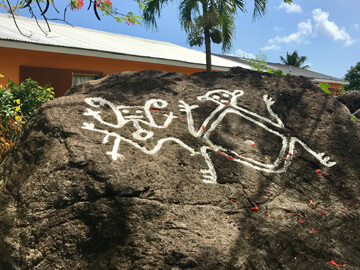
Carib Petroglyphs
St. Kitts' history traces back millennia, and nowhere does that become more apparent than along Wingfield Road and Stone Fort River. The island is home to hundreds of ancient rock carvings, the most prominent of which can be found, traced in white paint, on a boulder along the route to Wingfield Estate. If you're looking for quantity, though, head for the southern half of the island; a 20th-century study of Stone Fort River found 115 petroglyphs etched into its ravine's craggy walls. We recommend a guided hike, but venture at your own risk: These are the old religious grounds of the Caribs. Some say the area's bees are the spirits of the island's ancient indigenous people — and they will protect their land!
-
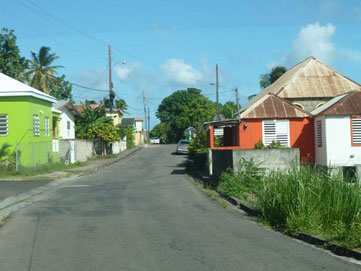
Half Way Tree Village
In 1625, Thomas Warner's small British colony greeted the unexpected arrival of a French ship, which had suffered an unfortunate encounter with a Spanish warship. Captain Pierre Belain d’Esnambue and his crew limped into St. Kitts to make much-needed repairs. Clearly impressed with what he saw, he returned soon afterwards with a small group of colonists. Initially, the French presence was received in friendship (or was at least tolerated). The two groups chose the great tamarind tree of Half Way Tree Village to mark the border between the French and British territories on St. Kitts. As the colonies grew and prospered, this border would be sorely tested.
-
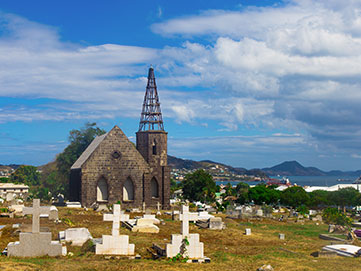
Springfield Cemetery and Chapel
Until the Cholera Epidemic in 1854, all burials would take place in churchyard cemeteries. It was estimated that one sixth of the population died from the disease. To solve the 'dangerous' health problem posed by the cholera epidemic, the Government purchased land at Springfield for use as a Cemetery for the Parish of St. George. In 1858, legislation was passed prohibiting burials anywhere in Basseterre except at the Springfield Cemetery. In 1862, the Mortuary Chapel in Springfield Cemetery was erected at public expense for use by all religious denominations to conduct services for those persons who had died at the nearby Cunningham Hospital.
-
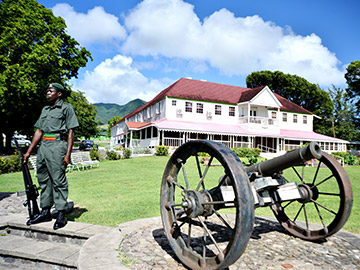
The Government House
Around the time of Emancipation (1834), a planter-merchant and Vestryman called Thomas Harper bought this new property and named it Springfield. In 1848 it became the official residence of the revered Francis Robert Brathwaite, when he procured Springfield as a more fitting accommodation for his new position as the first Archdeacon of the Diocese of Antigua. Today Springfield House serves as the official residence of the Governor General of the Federation of St. Kitts and Nevis.
-
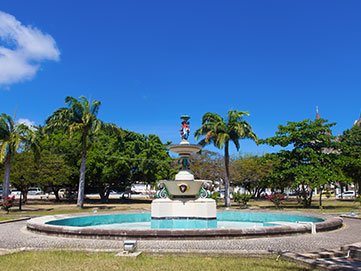
Independence Square
Originally known as Pall Mall Square, this area was renamed when St. Kitts and Nevis achieved political independence on September 19, 1983. Besides its new moniker, though, the space itself serves as a reminder of the island's long path to freedom. When it was first acquired in 1750, it functioned as Basseterre's administrative, social, and commercial hub. Countless slaves, ferried here by ship, were sold on this site; the cellars where they were held can still be seen in the colonial-era buildings that surround the square.
-
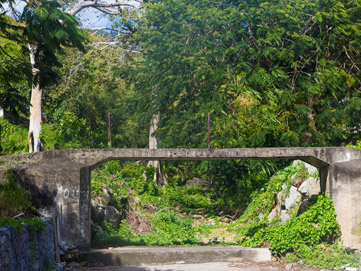
Bloody Point
By 1626 both the British and the French settlements were expanding at such a rate that the Carib community began to perceive a threat to its very existence on the island. Joining forces with Caribs from a number of other islands, Chief Tegremante prepared to attack the European settlements. Meanwhile, despite growing animosity between the French and the British, the two communities put aside their differences in order to mount a combined, pre-emptive attack on the Carib. As a result, tragically over 2,000 Carib Indians were massacred at Bloody Point.
-
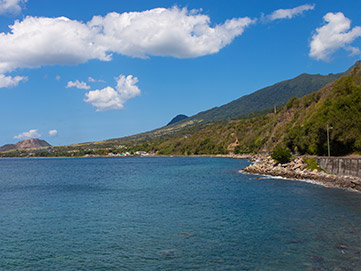
Old Road Bay
It was here at Old Road Bay that Sir Thomas Warner, along with his family and along with 14 other colonists began the first permanent European settlement in the Leeward Islands. Initially, the settlers were on good terms with the island's Carib inhabitants, although this friendship would be shortlived. Rather than cultivating sugar, it was tobacco that had drawn Warner to the island, and it was the island's tobacco crop that first supported the settlement. The Warner family estate served as the capital of St. Kitts until 1727, when it was moved to Basseterre. Outside of Old Road Bay a number of interesting Carib petroglyphs can be found.
-
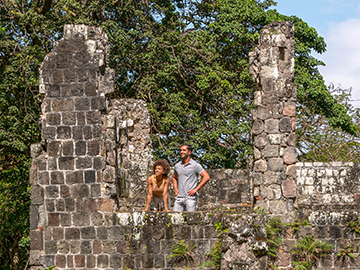
Wingfield River and Water Works
When the English arrived in the 1600s, and were allowed to settle between the two rivers (Wingfield and East Rivers) at Old Road, the Caribs were concentrated in the area around Wingfield River. After the evictions of the Caribs in 1629, the English settled the lands in the area and cultivated tobacco, ginger, indigo and cotton. With the introduction of sugar in the 1640’s, Wingfield developed into a major sugar plantation and one of the very few on the island to use water to power its factory works. The aqueduct is a unique architectural feature on the island and found only at Wingfield Estate Yard. The nearby river and its forested watershed has always been a major resource for the area. Like all plantations on St. Kitts, Wingfield provided for its own fresh water needs. Since the 19th Century it has formed part of the public water supply system serving the population on the leeward side of the island.
-
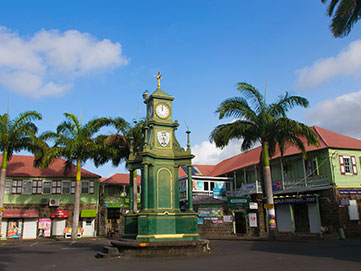
Berkeley Memorial
Built in 1883, this memorial stands at the center of Basseterre's Circus. It honors Thomas Berkeley Hardtman-Berkeley, an important figure in St. Kitts' history. Born in Sandy Point in 1824, he would go on to own six estates across the island — Fountain, Greenland, Greenhill, Ottleys, Shadwell, and Stone Fort. Berkeley also held a number of influential positions: Throughout his life, he served as a colonel in the Kittitian militia, President of the General Legislative Council, and Vice President of the Federal Council of the Leeward Islands. After his death in 1881, George Smith and Co of Glasgow, Scotland, designed a monument in his name and erected it in the heart of St. Kitts' capital. It has stood there ever since.

